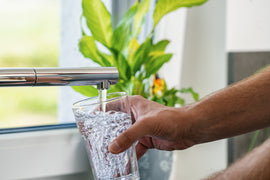Bottled water has been popular for decades, mainly due to the convenience and perceived inexpensive cost. However, convenience has its own price to pay with regards to human health, the environment, and can become costlier than you might think. According to Business Insider, bottled water costs nearly 2,000 times more than tap water. For those who are focused on their personal money management, switching from bottled water to filtration at the tap makes practical financial sense.
Though people prefer the taste of filtered water over what’s available from the faucet, FloFaucet provides you with great-tasting water while using the natural resources available for you right at your own kitchen sink. These are all things to consider when you want to stop wasting money on bottled water, especially when there are better solutions available.
#1: BPA Creates Adverse Human Health Effects
One of the many reasons to make the switch from drinking bottled water is the risk it poses to human health. A collaborative study between Arizona State University (ASU) and John Hopkins University (JHU) discusses the negative impact of plastic components, particularly bisphenol A or BPA. Health issues include reproductive issues in both men and women, aggressive behavior, and obesity.
Although many manufacturers have reduced or eliminated the use of BPA from its bottled water, cumulative exposure can still cause harm. A study performed by the Harvard School of Public Health found drinking cold liquids from polycarbonate bottles for just seven days increased urinary BPA levels by 69 percent, and the leaching of BPA was increased if the study participants drank hot liquids from the bottles.
#2: Reusable Water Bottles Motivate You to Drink More Water
Not only does learning how to stop wasting money on bottled water help reduce costs, it also improves your health. By using BPA-free reusable water bottles, it greatly reduces your exposure to toxins and eliminates the need for plastic water bottles altogether. It also motivates you to drink more water throughout the day.
You’d need to drink about four or five bottles of water per day to reach the daily recommended water intake. When relying on plastic water bottles to meet this goal, it’s easy to run out quickly.
By having both the conveniences and the crisp taste of purified water readily available, it can keep you on track with your water drinking goals and keep you from turning to other sugary or caffeinated beverages instead.
Staying hydrated is one of the main factors in preserving good health. Drinking water regularly throughout the day helps keep you more focused, energized, and boosts the immune system. Having access to fresh, filtered water at your sink allows you to fill up as many times as you want throughout the day. It also allows you to fill up a larger water container than the average 16.9 oz. plastic water bottles.
#3: Plastic Water Bottles Are Harmful to the Environment
For those who are concerned about how to prevent pollution, you should think twice before you purchase any more plastic water bottles. Once you’re done drinking a bottle of water and throw it into your at-home or public recycling bin, the hope is that it’ll be recycled. Unfortunately, that’s not the case. According to the U.S. Environmental Protection Agency, only 29 percent of plastic bottles are recycled. The remaining majority makes its way to landfills, which eventually are overrun due to mass accumulation and spill into the ocean.
A report from the Ellen MacArthur Foundation in partnership with the World Economic Forum, shared that the oceans could have more plastic (937 million tons) than fish (895 million tons) by 2050. That projection is based on the fact that plastic use has increased 20-fold over the past 50 years.
Additionally, the above-referenced ASU and JHU study focusing on the harmful effects of BPA also breaks down the current ways plastics are recycled and how more sustainable options are required to protect the environment. It points out that plastic water bottle disposal in landfills diminishes land resources, and the protective liners that separate landfills from the soil may leak or rupture over time, which contaminants natural water sources.
One of the solutions the study provides is to further research the benefits of biodegradable plastics, although this still presents challenges as these must be separated out from those that are not easily broken down. Restrictions on plastic usage to sustainable levels is the key to protecting the environment and reducing the amount of toxins released into the air.
#4: Bottled Water Is Not as Available As It Once Was
Another reason to stop spending money on bottled water is because it’s slowly dying out as a go-to resource. People want alternative options to bottled water without having to sacrifice convenience. As a result, many public spaces, including airports, hotels, and places of business, supply purified water refill stations as they eliminate the sale or availability of single-use plastic water bottles.
It costs money and energy to source, package, ship, distribute, and then recycle plastic water bottles. Since this isn’t a sustainable option, carrying a reusable water bottle has become more of the norm rather than relying on individual bottles of water being available wherever you go.
Many states and local communities have updated their public water systems from faulty fountains that dispense tap water to one-touch refill stations that supply chilled, purified water on-demand. They, too, have learned how to stop wasting money on bottled water while still providing the amenity to residents, guests, and visitors passing through.
As the world moves forward in its efforts to reduce plastic waste, bottled water will become more scarce and likely more expensive. Installing an at-home faucet filter, such as FloFaucet, gives you all the benefits of fresh, great-tasting water without the strain on your budget, the environment, or your health. By changing your bottled water habits now, you’re preparing for the future and saving money at the same time.
#5: Bottled Water Brands May Be Selling Tap Water
Finally, it may come as a surprise that your previously favored bottled water brand actually is selling the illusion of purified water. Have you ever noticed just how many bottled water brands are available? With eye-catching logos, vague or questionable claims of where the water is sourced, and a push for benefits like electrolytes and minerals, it all seems like you’re receiving the best product available.
However, per reports, including CNN, Pepsi is one brand that admitted its bottled water, Aquafina, is actually tap water. Coca-Cola’s Dasani brand also comes from a public water supply, as does Nestle’s All Nestle Pure Life Purified Drinking Water. Furthermore, the National Resource Defense Council completed a four-year review of the safety standards within the bottled water industry and concluded that approximately 25 percent or more of bottled water is tap water. This statistic is especially concerning with the increase of pharmaceuticals in water. There’s no assurance for those drinking it that it’s any safer or cleaner than tap water as sometimes it’s treated and other times, it’s not.
Rather than buying into the packaging of bottled water or how it’s marketed, a wise personal money management decision is to install FloFaucet, which transforms the tap water already available to you.
FloFaucet saves your household $700 a year when compared to the cost of drinking bottled water. For a one-time investment, you’re able to have purified water available to you at any time without any plastic waste to clutter up your home. It’s guaranteed to remove or reduce 80+ known contaminants, through a five-stage micro carbon block filter process, which makes it cleaner and taste better.
Plus, it’s simple to install, easy to use, and has twice the flow rate of the typical faucet filter. This is all in addition to knowing exactly where your water is sourced from and how it’s treated before you drink it.
FloWater Provides a Purified Water Solution at Home
Take charge of your personal money management by using an at-home faucet filter like FloFaucet. You’ll get the taste of clean, purified water without the high cost of bottled water that may be sourced similarly as the water that comes out of your tap but costs significantly more. There’s also the option of investing in a home water dispenser, which also transforms your tap water into purified water. It, too, eliminates up to 99 percent of all toxins, viruses, bacteria, and other contaminants and pollutants typically found in water from the faucet.
With an easy, one-touch refill, it’s efficient for everyone in your family to use and benefit from purified, chilled water. As part of its seven-stage system, the FloWater Refill Station includes an electrolytes-enhancement filter to add in potassium, sodium, calcium, and magnesium for your health, as well as an alkaline enhancement that helps neutralize the pH level of the water from your tap. Regardless of which solution you opt for, it allows you to save money for your family while providing reliable resources of clean water on a regular basis.
What may have been a favorable solution in the past with bottled water is no longer applicable New advancements in at-home filtered water systems provide the benefit of having purified water in your home without the cost to your health, environment, and budget.
Sources:
https://www.businessinsider.com/bottled-water-facts-science-healthy-2017-4
https://money.cnn.com/2007/07/27/news/companies/pepsi_coke/
https://www.nrdc.org/stories/truth-about-tap
https://www.ncbi.nlm.nih.gov/pmc/articles/PMC3791860/
http://www3.weforum.org/docs/WEF_The_New_Plastics_Economy.pdf





